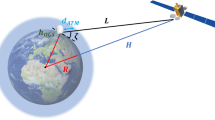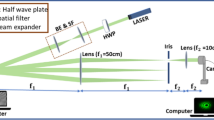Abstract
This paper addresses the problem of direction-of-arrival (DOA) estimation of multiple sources for spatial optical beam forming network (SOBFN). A method which utilizes sparse Bayesian learning techniques to reconstruct the spatial power spectrum of the signals is proposed. The reconstruction procedure takes advantage of the amplitude distribution of the fiber-array output and the spatial sparsity of the incident signals. The reconstructed spectrum contains some evident peaks that indicate the coarse directions of the radiation sources. Then, a linear interpolation procedure is applied to make the DOA estimation results more precise. Sufficient numerical simulations are carried out to verify the performance of the proposed algorithm. Simulation results show that the proposed method fits well with the signal model of SOBFN and has favorable DOA estimation performance.






Similar content being viewed by others
References
Keopf, G.A.: Optical processor for phased-array beam formation. Proc. SPIE Int. Soc. Opt. Eng. 477(6), 75–81 (1984)
Konishi, Yoshihiko, Chujo, Wataru, Fujise, Masayuki: Carrier-to-noise ratio and sidelobe level in a two-laser model optically controlled array antenna using Fourier optics. IEEE Trans. Antennas Propag. 40(12), 1459–1465 (1992)
Te-kao, Wu, Chandler, Charles W.: Optical beam forming techniques for phased array antennas. Int. J. lnfrared Millimeter Waves 14(6), 1191–1199 (1993)
Ji, Y., Inagaki, K., Miura, R., Karasawa, Y.: Optical processor for multibeam microwave array antennas. Electron. Lett. 32(9), 822–824 (1996)
Ji, Yu., Keizo, Inagaki, Osamu, Shibata: Receive mode of optical signal processing multibeam array antennas. IEEE Microw. Guided Wave Lett. 8(7), 251–253 (1998)
Akiyama, Tomohiro, Inagaki, Keizo, Ohira, Takashi, Hikita, Makoto: Two-dimensional optical signal-processing beamformer using multilayer polymeric optical waveguide arrays. IEEE Trans. Microw. Theory Tech. 49(10), 2055–2061 (2001)
Shibata, O., Inagaki, K.: Spatial optical beam-forming network for receiving-mode multibeam array antenna proposal and experiment. IEEE Trans. Microw. Theory Tech. 50(5), 205–208 (2002)
Inagaki, K., Karasawa, Y.: Spatial optical signal processing beam-forming network for 2D beam steering. IEICE Trans. Electron. 86(7), 1209–1217 (2003)
Braker, B.M., Schlottau, F., Wagner, K.: Squint-free Fourier-optical RF beamforming using a SHB crystal as an imaging detector. IEEE J. Sel. Top. Quantum Electron. 14(3), 952–962 (2008)
Liang, Wu, Zai-chen, Zhang, Hua-ping, Liu: Transmit beam-forming for MIMO optical wireless communication systems. Wirel. Pers. Commun. 78(1), 615–628 (2014)
Liu-Li, Wu, Liu, Zhang-Meng, Jiang, Wen-Li: A direction of arrival estimation method for spatial optical beam-forming network. Opt. Quantum Electron. 47(8), 3041–3051 (2015)
Liu, Zhang-Meng, Huang, Zhi-Tao, Zhou, Yi-Yu.: An efficient maximum likelihood method for direction-of-arrival estimation via sparse Bayesian learning. IEEE Trans. Wirel. Commun. 11(10), 1–11 (2012)
Liu, Zhang-Meng, Huang, Zhi-Tao, Zhou, Yi-Yu.: Sparsity-inducing direction finding for narrowband and wideband signals based on array covariance vectors. IEEE Trans. Wirel. Commun. 12(8), 1–12 (2013)
Liu, Zhang-Meng, Zhou, Yi-Yu.: A unified framework and sparse Bayesian perspective for direction-of-arrival estimation in the presence of array imperfections. IEEE Trans. Signal Process. 61(15), 3786–3798 (2013)
Tipping, M.E.: Sparse Bayesian learning and the relevance vector machine. J. Mach. Learn. Res. 1(3), 211–244 (2001)
Wipf, D.P., Rao, B.D., Nagarajan, S.: Latent variable Bayesian models for promoting sparsity. IEEE Trans. Inf. Theory 57(9), 6236–6255 (2011)
Malioutov, D.M., Cetin, M., Willsky, A.S.: Optimal sparse representations in general overcomplete bases. Int. Conf. Acoust. Speech Signal Process. ICASSP 2(2), ii-793–ii-796 (2004)
B, A.P., Laird, N.M., Rubin, D.B.: Maximum likelihood from incomplete data via the EM algorithm. J. R. Stat. Soc. 39, 1–38 (1977)
Boyles, R.A.: On the convergence of the EM algorithm. J. R. Stat. Soc. B. 45(1), 47–55 (1983)
Acknowledgments
The work is supported by the National Natural Science Foundation of China (No. 61302141).
Author information
Authors and Affiliations
Corresponding author
Rights and permissions
About this article
Cite this article
Wu, Ll., Liu, Zm. & Jiang, Wl. A direction finding method for spatial optical beam-forming network based on sparse Bayesian learning. SIViP 11, 203–209 (2017). https://doi.org/10.1007/s11760-016-0920-7
Received:
Revised:
Accepted:
Published:
Issue Date:
DOI: https://doi.org/10.1007/s11760-016-0920-7




